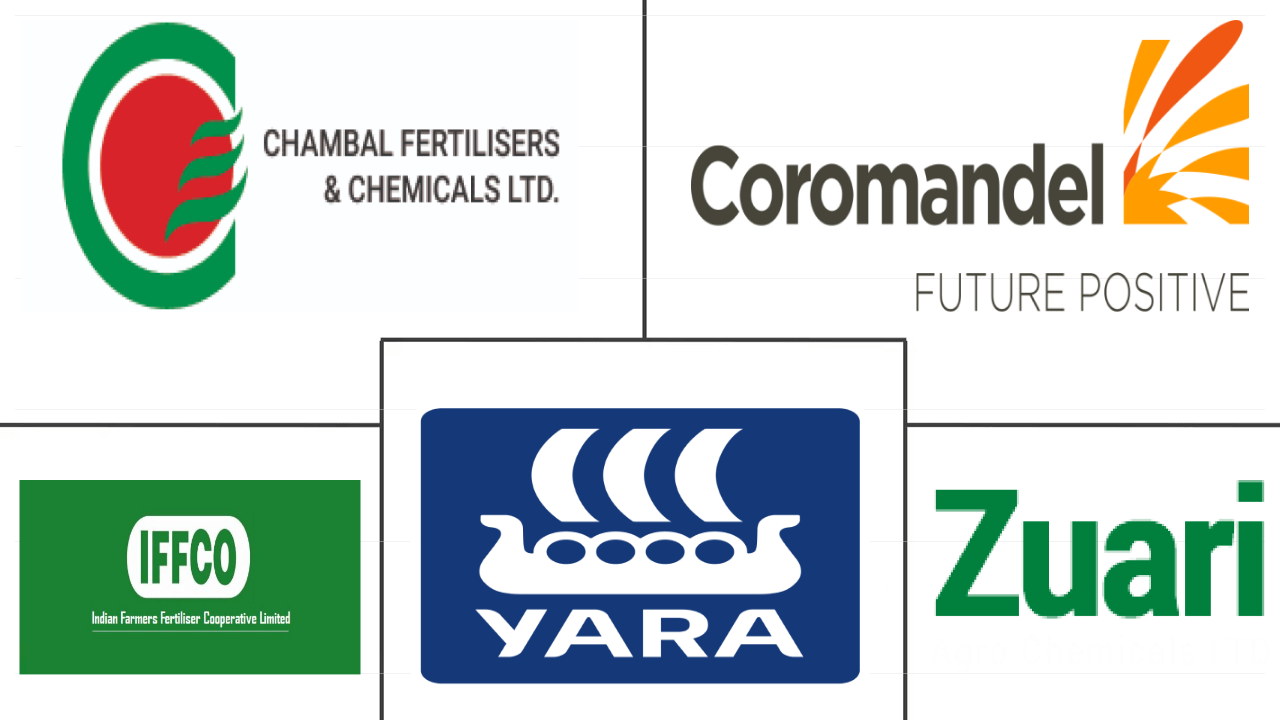Market Size of asia-pacific micronutrient fertilizer Industry
|
|
Study Period | 2017 - 2030 |
|
|
Market Size (2024) | USD 1.85 Billion |
|
|
Market Size (2030) | USD 2.77 Billion |
|
|
Largest Share by Product | Copper |
|
|
CAGR (2024 - 2030) | 6.96 % |
|
|
Largest Share by Country | India |
Major Players |
||

|
||
|
*Disclaimer: Major Players sorted in no particular order |
Asia-Pacific Micronutrient Fertilizer Market Analysis
The Asia-Pacific Micronutrient Fertilizer Market size is estimated at 1.85 billion USD in 2024, and is expected to reach 2.77 billion USD by 2030, growing at a CAGR of 6.96% during the forecast period (2024-2030).
1.85 Billion
Market Size in 2024 (USD)
2.77 Billion
Market Size in 2030 (USD)
4.96 %
CAGR (2017-2023)
6.96 %
CAGR (2024-2030)
Largest Segment by Type
32.15 %
value share, Copper, 2023
Increasing copper deficiencies in the countries like China, India and Vietanm and growing awareness of micronutrient deficiencies including copper will drive the market.
Fastest Growing Type
8.17 %
Projected CAGR, Boron, 2024-2030
Most of the soils in the region are sandy, highly leached and calcarious soils making them boron deficient and thus driving the market growth during forecast period.
Largest Segment by Crop Type
83.83 %
value share, Field Crops, 2023
Shifting focus toward balanced nutrition, increasing area under field crops, and need to maintain micronutrient levels in the soil for the proper growth may drive the market
Largest segment by Country
41.50 %
value share, India, 2023
India dominated the market owing to adoption of intensive and modern cropping practices with high-yielding cultivars resulted in increased micronutrient deficiencies.
Leading Market Player
9.78 %
market share, Yara International ASA, 2022

Its success largely stems from the supply of its specialized foliar micronutrient products, branded as YaraVita, formulated with premium nutrient compounds.
Growing awareness and their importance in the agriculture production may drive the market in the region
- Boron was the most consumed micronutrient in the region, with a consumption volume share of 26.5% in 2022. The majority of boron consumption is attributed to the region's soils, which have reduced water content and higher nitrogen levels that limit boron uptake by plants, leading to increased utilization of boron micronutrients.
- In Asia-Pacific, zinc held the second-largest market share in terms of consumption, with a share of 26.2% and a volume of 159.1 thousand metric tons in 2022. The demand for zinc is anticipated to continue rising in the coming years due to its vital role in the growth and development of plants.
- Copper accounted for 28.6% of the Asia-Pacific micronutrient market's value in the region in 2022. It is an important micronutrient needed in small quantities. It acts as a catalyst in many important plant reactions during growth and plays a key role in protein formation.
- Iron was the third most-consumed micronutrient fertilizer in the region, accounting for a 20.8% share among all micronutrients in 2022. Iron plays an important role in a plant's growth and development as it contains many enzymes and acts as a catalyst in chlorophyll formation. The growing iron deficiency in the soil is expected to fuel the growth of the market.
- Hence, owing to factors like the need for higher yield and productivity and the growing knowledge among farmers about their importance in crop cultivation, the market for micronutrients in the region is anticipated to grow between 2023 and 2030 with a value CAGR of 6.8%.
Nutrient deficiencies and growing awareness among farmers regarding malnutrition problems may drive the market
- In 2022, India and China emerged as the dominant players in the Asia-Pacific micronutrient fertilizer market, capturing 41.7% and 31.7% of the market share, respectively. The Centre for Science and Environment (CSE) highlighted India's soil deficiencies, with boron, iron, and zinc being the most prominent, at 47%, 37%, and 39% respectively. This makes India the leading market in the region, although it fares better in terms of copper and manganese deficiencies.
- Recognizing the gravity of fertilizer overuse, the Chinese government introduced the "Action Plan for the Zero Increase of Fertilizer Use." This regulation has curtailed the usage of fertilizers, including micronutrient variants. Consequently, the growth rate of micronutrients, especially in the field crops segment, has been limited to a modest CAGR of 3.8%.
- Studies have consistently highlighted the prevalence of boron deficiency in countries like Korea, Malaysia, and Taiwan. This deficiency is particularly pronounced in volcanic, acidic, and calcareous soils, significantly impacting crops like peanuts, soybeans, papaya, and citrus. As a result, the market for boron micronutrient fertilizers has witnessed a surge.
- The Food and Fertilizer Technology Centre for the Asian and Pacific Region has observed that applying micronutrients through the foliar mode, such as 0.5% iron sulfate, manganese sulfate, and 0.1% copper sulfate, at the recommended dosages, effectively mitigates crop deficiency symptoms.
- Given the imperative of ensuring food security, the demand for micronutrient fertilizers in Asia-Pacific is projected to register a robust CAGR of 6.8% during 2023-2030.
Asia-Pacific Micronutrient Fertilizer Industry Segmentation
Boron, Copper, Iron, Manganese, Molybdenum, Zinc, Others are covered as segments by Product. Fertigation, Foliar, Soil are covered as segments by Application Mode. Field Crops, Horticultural Crops, Turf & Ornamental are covered as segments by Crop Type. Australia, Bangladesh, China, India, Indonesia, Japan, Pakistan, Philippines, Thailand, Vietnam are covered as segments by Country.
- Boron was the most consumed micronutrient in the region, with a consumption volume share of 26.5% in 2022. The majority of boron consumption is attributed to the region's soils, which have reduced water content and higher nitrogen levels that limit boron uptake by plants, leading to increased utilization of boron micronutrients.
- In Asia-Pacific, zinc held the second-largest market share in terms of consumption, with a share of 26.2% and a volume of 159.1 thousand metric tons in 2022. The demand for zinc is anticipated to continue rising in the coming years due to its vital role in the growth and development of plants.
- Copper accounted for 28.6% of the Asia-Pacific micronutrient market's value in the region in 2022. It is an important micronutrient needed in small quantities. It acts as a catalyst in many important plant reactions during growth and plays a key role in protein formation.
- Iron was the third most-consumed micronutrient fertilizer in the region, accounting for a 20.8% share among all micronutrients in 2022. Iron plays an important role in a plant's growth and development as it contains many enzymes and acts as a catalyst in chlorophyll formation. The growing iron deficiency in the soil is expected to fuel the growth of the market.
- Hence, owing to factors like the need for higher yield and productivity and the growing knowledge among farmers about their importance in crop cultivation, the market for micronutrients in the region is anticipated to grow between 2023 and 2030 with a value CAGR of 6.8%.
| Product | |
| Boron | |
| Copper | |
| Iron | |
| Manganese | |
| Molybdenum | |
| Zinc | |
| Others |
| Application Mode | |
| Fertigation | |
| Foliar | |
| Soil |
| Crop Type | |
| Field Crops | |
| Horticultural Crops | |
| Turf & Ornamental |
| Country | |
| Australia | |
| Bangladesh | |
| China | |
| India | |
| Indonesia | |
| Japan | |
| Pakistan | |
| Philippines | |
| Thailand | |
| Vietnam | |
| Rest of Asia-Pacific |
Asia-Pacific Micronutrient Fertilizer Market Size Summary
The Asia-Pacific micronutrient fertilizer market is experiencing significant growth, driven by the increasing need for enhanced agricultural productivity and soil health. Zinc is the most widely used micronutrient in the region, primarily due to its effectiveness in addressing soil deficiencies and improving crop yields. Iron, manganese, and copper also play crucial roles in plant development, contributing to their substantial consumption. The market is characterized by a preference for specialty fertilizers, which are often applied through foliar spraying to quickly address nutrient deficiencies. This trend is supported by the growing awareness among farmers about the benefits of micronutrient fertilizers in crop cultivation.
India and China are the leading markets within the region, with India being the largest due to its significant soil deficiencies in boron, iron, and zinc. The demand for micronutrient fertilizers is expected to rise, fueled by the need to ensure food security amidst a growing population. However, regulatory measures in China aimed at reducing fertilizer usage have impacted the market. The industry is moderately consolidated, with major players like Chambal Fertilizers & Chemicals Ltd, Coromandel International Ltd., and YARA International Ltd. dominating the landscape. Recent developments include strategic agreements and product launches aimed at enhancing fertilizer efficiency and addressing urban gardening needs.
Asia-Pacific Micronutrient Fertilizer Market Size - Table of Contents
-
1. MARKET SEGMENTATION (includes market size in Value in USD and Volume, Forecasts up to 2030 and analysis of growth prospects)
-
1.1 Product
-
1.1.1 Boron
-
1.1.2 Copper
-
1.1.3 Iron
-
1.1.4 Manganese
-
1.1.5 Molybdenum
-
1.1.6 Zinc
-
1.1.7 Others
-
-
1.2 Application Mode
-
1.2.1 Fertigation
-
1.2.2 Foliar
-
1.2.3 Soil
-
-
1.3 Crop Type
-
1.3.1 Field Crops
-
1.3.2 Horticultural Crops
-
1.3.3 Turf & Ornamental
-
-
1.4 Country
-
1.4.1 Australia
-
1.4.2 Bangladesh
-
1.4.3 China
-
1.4.4 India
-
1.4.5 Indonesia
-
1.4.6 Japan
-
1.4.7 Pakistan
-
1.4.8 Philippines
-
1.4.9 Thailand
-
1.4.10 Vietnam
-
1.4.11 Rest of Asia-Pacific
-
-
Asia-Pacific Micronutrient Fertilizer Market Size FAQs
How big is the Asia-Pacific Micronutrient Fertilizer Market?
The Asia-Pacific Micronutrient Fertilizer Market size is expected to reach USD 1.85 billion in 2024 and grow at a CAGR of 6.96% to reach USD 2.77 billion by 2030.
What is the current Asia-Pacific Micronutrient Fertilizer Market size?
In 2024, the Asia-Pacific Micronutrient Fertilizer Market size is expected to reach USD 1.85 billion.

